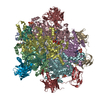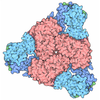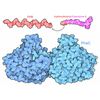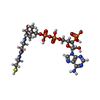[English] 日本語
 Yorodumi
Yorodumi- PDB-8pn8: Engineered glycolyl-CoA carboxylase (L100N variant) with bound CoA -
+ Open data
Open data
- Basic information
Basic information
| Entry | Database: PDB / ID: 8pn8 | ||||||||||||
|---|---|---|---|---|---|---|---|---|---|---|---|---|---|
| Title | Engineered glycolyl-CoA carboxylase (L100N variant) with bound CoA | ||||||||||||
 Components Components |
| ||||||||||||
 Keywords Keywords |  LIGASE / glycolyl-CoA carboxylase LIGASE / glycolyl-CoA carboxylase | ||||||||||||
| Function / homology |  Function and homology information Function and homology information propionyl-CoA carboxylase / propionyl-CoA carboxylase /  propionyl-CoA carboxylase activity / lipid catabolic process / propionyl-CoA carboxylase activity / lipid catabolic process /  ATP binding / ATP binding /  metal ion binding metal ion bindingSimilarity search - Function | ||||||||||||
| Biological species |   Methylorubrum extorquens AM1 (bacteria) Methylorubrum extorquens AM1 (bacteria) | ||||||||||||
| Method |  ELECTRON MICROSCOPY / ELECTRON MICROSCOPY /  single particle reconstruction / single particle reconstruction /  cryo EM / Resolution: 2.31 Å cryo EM / Resolution: 2.31 Å | ||||||||||||
 Authors Authors | Zarzycki, J. / Marchal, D.G. / Schulz, L. / Prinz, S. / Erb, T.J. | ||||||||||||
| Funding support | European Union,  Germany, 3items Germany, 3items
| ||||||||||||
 Citation Citation |  Journal: ACS Synth Biol / Year: 2023 Journal: ACS Synth Biol / Year: 2023Title: Machine Learning-Supported Enzyme Engineering toward Improved CO-Fixation of Glycolyl-CoA Carboxylase. Authors: Daniel G Marchal / Luca Schulz / Ingmar Schuster / Jelena Ivanovska / Nicole Paczia / Simone Prinz / Jan Zarzycki / Tobias J Erb /  Abstract: Glycolyl-CoA carboxylase (GCC) is a new-to-nature enzyme that catalyzes the key reaction in the tartronyl-CoA (TaCo) pathway, a synthetic photorespiration bypass that was recently designed to improve ...Glycolyl-CoA carboxylase (GCC) is a new-to-nature enzyme that catalyzes the key reaction in the tartronyl-CoA (TaCo) pathway, a synthetic photorespiration bypass that was recently designed to improve photosynthetic CO fixation. GCC was created from propionyl-CoA carboxylase (PCC) through five mutations. However, despite reaching activities of naturally evolved biotin-dependent carboxylases, the quintuple substitution variant GCC M5 still lags behind 4-fold in catalytic efficiency compared to its template PCC and suffers from futile ATP hydrolysis during CO fixation. To further improve upon GCC M5, we developed a machine learning-supported workflow that reduces screening efforts for identifying improved enzymes. Using this workflow, we present two novel GCC variants with 2-fold increased carboxylation rate and 60% reduced energy demand, respectively, which are able to address kinetic and thermodynamic limitations of the TaCo pathway. Our work highlights the potential of combining machine learning and directed evolution strategies to reduce screening efforts in enzyme engineering. | ||||||||||||
| History |
|
- Structure visualization
Structure visualization
| Structure viewer | Molecule:  Molmil Molmil Jmol/JSmol Jmol/JSmol |
|---|
- Downloads & links
Downloads & links
- Download
Download
| PDBx/mmCIF format |  8pn8.cif.gz 8pn8.cif.gz | 851.9 KB | Display |  PDBx/mmCIF format PDBx/mmCIF format |
|---|---|---|---|---|
| PDB format |  pdb8pn8.ent.gz pdb8pn8.ent.gz | 693 KB | Display |  PDB format PDB format |
| PDBx/mmJSON format |  8pn8.json.gz 8pn8.json.gz | Tree view |  PDBx/mmJSON format PDBx/mmJSON format | |
| Others |  Other downloads Other downloads |
-Validation report
| Arichive directory |  https://data.pdbj.org/pub/pdb/validation_reports/pn/8pn8 https://data.pdbj.org/pub/pdb/validation_reports/pn/8pn8 ftp://data.pdbj.org/pub/pdb/validation_reports/pn/8pn8 ftp://data.pdbj.org/pub/pdb/validation_reports/pn/8pn8 | HTTPS FTP |
|---|
-Related structure data
| Related structure data |  17778MC  8pn7C M: map data used to model this data C: citing same article ( |
|---|---|
| Similar structure data | Similarity search - Function & homology  F&H Search F&H Search |
- Links
Links
- Assembly
Assembly
| Deposited unit | 
|
|---|---|
| 1 |
|
- Components
Components
| #1: Protein | Mass: 55990.953 Da / Num. of mol.: 6 Source method: isolated from a genetically manipulated source Source: (gene. exp.)   Methylorubrum extorquens AM1 (bacteria) Methylorubrum extorquens AM1 (bacteria)Gene: pccB, MexAM1_META1p0172 / Production host:   Escherichia coli BL21(DE3) (bacteria) / References: UniProt: C5AP75, Escherichia coli BL21(DE3) (bacteria) / References: UniProt: C5AP75,  propionyl-CoA carboxylase propionyl-CoA carboxylase#2: Protein | Mass: 71986.961 Da / Num. of mol.: 6 Source method: isolated from a genetically manipulated source Source: (gene. exp.)   Methylorubrum extorquens AM1 (bacteria) Methylorubrum extorquens AM1 (bacteria)Gene: pccA, MexAM1_META1p3203 / Production host:   Escherichia coli BL21(DE3) (bacteria) / References: UniProt: C5AWU5, Escherichia coli BL21(DE3) (bacteria) / References: UniProt: C5AWU5,  propionyl-CoA carboxylase propionyl-CoA carboxylase#3: Chemical | ChemComp-COA /  Coenzyme A Coenzyme A#4: Chemical | ChemComp-BTI / #5: Water | ChemComp-HOH / |  Water WaterHas ligand of interest | Y | |
|---|
-Experimental details
-Experiment
| Experiment | Method:  ELECTRON MICROSCOPY ELECTRON MICROSCOPY |
|---|---|
| EM experiment | Aggregation state: 2D ARRAY / 3D reconstruction method:  single particle reconstruction single particle reconstruction |
- Sample preparation
Sample preparation
| Component | Name: glycolyl-CoA carboxylase with bound CoA / Type: COMPLEX / Entity ID: #1-#2 / Source: RECOMBINANT |
|---|---|
| Molecular weight | Units: MEGADALTONS / Experimental value: NO |
| Source (natural) | Organism:   Methylorubrum extorquens AM1 (bacteria) Methylorubrum extorquens AM1 (bacteria) |
| Source (recombinant) | Organism:   Escherichia coli BL21(DE3) (bacteria) Escherichia coli BL21(DE3) (bacteria) |
| Buffer solution | pH: 7.8 |
| Specimen | Embedding applied: NO / Shadowing applied: NO / Staining applied : NO / Vitrification applied : NO / Vitrification applied : YES : YES |
Vitrification | Instrument: FEI VITROBOT MARK IV / Cryogen name: ETHANE / Humidity: 100 % / Chamber temperature: 277 K |
- Electron microscopy imaging
Electron microscopy imaging
| Experimental equipment |  Model: Titan Krios / Image courtesy: FEI Company |
|---|---|
| Microscopy | Model: FEI TITAN KRIOS |
| Electron gun | Electron source : :  FIELD EMISSION GUN / Accelerating voltage: 300 kV / Illumination mode: FLOOD BEAM FIELD EMISSION GUN / Accelerating voltage: 300 kV / Illumination mode: FLOOD BEAM |
| Electron lens | Mode: BRIGHT FIELD Bright-field microscopy / Nominal defocus max: 2000 nm / Nominal defocus min: 500 nm Bright-field microscopy / Nominal defocus max: 2000 nm / Nominal defocus min: 500 nm |
| Image recording | Electron dose: 55 e/Å2 / Film or detector model: GATAN K3 (6k x 4k) |
- Processing
Processing
| EM software | Name: PHENIX / Version: 1.20.1_4487: / Category: model refinement |
|---|---|
CTF correction | Type: PHASE FLIPPING AND AMPLITUDE CORRECTION |
| Symmetry | Point symmetry : D3 (2x3 fold dihedral : D3 (2x3 fold dihedral ) ) |
3D reconstruction | Resolution: 2.31 Å / Resolution method: FSC 0.143 CUT-OFF / Num. of particles: 113824 / Symmetry type: POINT |
 Movie
Movie Controller
Controller



 PDBj
PDBj














